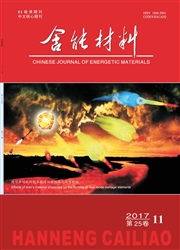

 中文摘要:
中文摘要:
为探讨溶剂对炸药晶体形貌的影响机制和溶剂的选择依据,采用附着能(AE)模型预测2,6-二氨基-3,5-二硝基吡啶-1-氧化物(ANPyO)在真空的晶体形貌,确定其主要生长晶面;并运用分子动力学(MD)模拟研究ANPyO晶面与溶剂N,N-二甲基甲酰胺(DMF)的相互作用及其本质,进而通过修正的AE模型预测其在DMF中的晶体形貌。结果表明:ANPyO在真空中的晶体形状接近椭圆,主要生长晶面为(110)、(100)、(11—2)及(10.1)面。溶剂与晶面间存在较强相互作用,径向分布函数分析表明相互作用能主要包括范德华作用,库仑作用和氢键。在溶剂DMF中,晶面的修正附着能绝对值顺序为(110)〈(11—2)〈(10—1)〈(100),ANPyO晶体形貌接近片状,与已有实验结果一致。此外,DMF分子在ANPyO晶面的扩散系数研究结果表明,扩散系数与修正附着能绝对值成线性关系,晶体生长形貌亦受溶剂扩散能力的影响。
 英文摘要:
英文摘要:
In order to understand the mechanism of the effect of solvent on the crystal morphology of explosives, and provide a gist for solvent selection, the attachment energy (AE) models were employed to predict the growth morphology and the main crystal faces of 2,6-diamino-3,5- dinitropyridine-1 -oxide(ANPyO) in vacuum. The molecular dynamics (MD) simulation was applied to investigate the interaction of ANPyO crystal faces and N, N-dimethylformamide (DMF) solvent, and the growth habit of ANPyO in DMF was predicted using the modified AE model. Results indicate that the morphology of ANPyO crystal in vacuum is dominated by the four faces of (11 0), (1 0 0), (10 -1) and (11 -2), and the crystal shape is similar to ellipsoid. The radial distribution function analysis shows that the solvent- crystal face interactions mainly consist of van der Waals forces, coulomb interaction and hydrogen bonds. In DMF, the absolute value of the corrected attachment energies change in the order of (110) 〈(112 ) 〈 (10 -1 )〈 (100) ,which causes the crystal morphology to become very close to a flake and accords well with the experiment results. Furthermore, the analysis of diffusion coefficient of DMF molecules on ANPyO crystal faces shows that diffusion coefficient changes linearly with the absolute value of the corrected attachment energies, and the growth habit is also affected by the diffusion capacity of solvent.
 同期刊论文项目
同期刊论文项目
 同项目期刊论文
同项目期刊论文
 期刊信息
期刊信息
